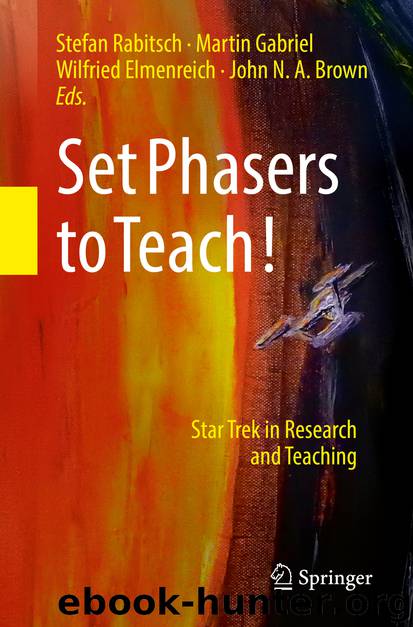Set Phasers to Teach! by Stefan Rabitsch & Martin Gabriel & Wilfried Elmenreich & John N. A. Brown

Author:Stefan Rabitsch & Martin Gabriel & Wilfried Elmenreich & John N. A. Brown
Language: eng
Format: epub
ISBN: 9783319737768
Publisher: Springer International Publishing
While we do not act out Star Trek scenes in class or do holodeck-like pantomime activities, seeing the clip of an episode works much the same way. Thinking deeply about topics is the first step to writing well. Lindemann adds, “Before writers can respond to a particular task, they must define a rhetorical problem. Defining the problem requires, at the least, assessing the writer’s relationship to the subject and the reader” [9, p. 192].
In addition to a discussion of the class’ assigned reading, the narrative of the TNG episode “Liaisons” [8] itself also offers another moment for conversation, reflection, and writing. Captain Picard (Patrick Stewart), after a shuttlecraft crash, must escape from a lonely woman’s clutches and rescue his injured pilot. In the end, though, both the woman holding Picard hostage and the injured male pilot are one and the same. The image of Picard kissing the woman who turns into the male pilot all in the same frame brings another level of discussion on gender and LGBTQ+ issues. Students can work in small groups, brainstorm other popular culture images like the one TNG presents, and create a plan that suits the assignment at hand all through viewing a short segment of the episode, guidance from faculty, and application of assigned reading. These sorts of activities and assignments, argues Isaacs, provide the moment where “[…] students can develop their abilities to marshal evidence in support of general claims, to analyze intellectually challenging ideas, and to write unified and cogent […] compositions through the pedagogies of process-writing instruction […]” [4, p. 100].
Gender and sexuality are two challenging ideas for students says James Smalls. He contends that his course “Roaming the Star Trek Universe: Race, Gender, and Alien Sexualities” has been successful, in part, because it provides students with a space to discuss “[…] critical issues of race, gender and alternate forms of sexuality. […] The science fiction genre, as part of popular culture, provides a seductive means of examining the intersections of the concerns of race, gender and sexuality in exciting and daring new ways […]” [2].
Apart from occasional potential “preachy” discussions on larger social issues, as some critics claim, Star Trek also focuses on problem solving. In a writing classroom, this is a needed skill throughout the course, but it is of special value when it comes to research writing. Learning how to write research questions is another area where students can benefit from Star Trek’s example. John C. Putnam illustrates a process of inquiry based on Star Trek and post-World War II American history. His method can be applied to many humanities-based courses. “By placing these issues and events in a different time and space, Star Trek can help students overcome stereotypes or personal biases”, Putnam explains [10, p. 519]. And moving past bias and generalizations is an important element in research-based writing. Putnam discusses his writing assignments, and to complete any of them, students must understand the concept of research questions.
Writing research questions is a skill needed for all college students, as Alexandra Tilsey highlights.
Download
This site does not store any files on its server. We only index and link to content provided by other sites. Please contact the content providers to delete copyright contents if any and email us, we'll remove relevant links or contents immediately.
The Art of Coaching Workbook by Elena Aguilar(51076)
Trainspotting by Irvine Welsh(21569)
Twilight of the Idols With the Antichrist and Ecce Homo by Friedrich Nietzsche(18566)
Fangirl by Rainbow Rowell(9175)
Periodization Training for Sports by Tudor Bompa(8210)
Change Your Questions, Change Your Life by Marilee Adams(7684)
This Is How You Lose Her by Junot Diaz(6833)
Asking the Right Questions: A Guide to Critical Thinking by M. Neil Browne & Stuart M. Keeley(5708)
Grit by Angela Duckworth(5554)
Red Sparrow by Jason Matthews(5424)
Paper Towns by Green John(5136)
Room 212 by Kate Stewart(5071)
Ken Follett - World without end by Ken Follett(4682)
Housekeeping by Marilynne Robinson(4391)
The Sports Rules Book by Human Kinetics(4342)
Double Down (Diary of a Wimpy Kid Book 11) by Jeff Kinney(4240)
Papillon (English) by Henri Charrière(4227)
The Motorcycle Diaries by Ernesto Che Guevara(4050)
Exercise Technique Manual for Resistance Training by National Strength & Conditioning Association(4018)
